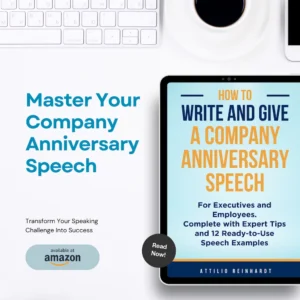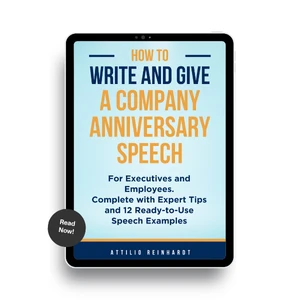How to Write and Give a Company Anniversary Speech is an essential guide providing strategies, templates, and examples that will help you create a speech that captures your company’s essence and leaves a lasting impression.
I have previously discussed the topic of anniversary speeches on this blog. Over the years, this subject has frequently been at the center of questions I’ve been asked while working as an emcee—questions from both executives and employees alike. Since I also conduct public speaking courses, I have always been happy to offer advice during breaks between rehearsals. However, there was a problem: this advice was always given quickly, in my spare time, without any in-depth analysis. Moreover, it’s a topic I can hardly address during my regular public speaking courses because it relates to very specific situations.
Consequently, I decided to write a manual that provides essential instructions for writing and delivering a speech for a company anniversary. The manual contains everything you need: advice, practical suggestions, and even 12 ready-to-use speech examples of varying lengths, suitable for different contexts.
What I consider most important, however, is that this book provides structure.
Structure forms the foundation of every meaningful speech—it is an essential element for communicating effectively with an audience in a business context. Therefore, I actually propose two different frameworks in the book: one for short speeches and one for longer presentations.
Structure: Two Frameworks
Here is an excerpt from the book, taken from the chapter where I discuss structure:
Remember, a company anniversary is a celebration, not a conference. Whether your speech is short or long, it
should honor the occasion, engage your audience, and be a pleasure to listen to.
1. The Simple Structure for Short Speeches
When time is limited, simplicity is key. A short speech should have:
1. A Clear Beginning: Greet your audience warmly and acknowledge the occasion.
2. A Middle: Deliver a key message or reflection—this could be a brief story, a highlight of the company’s
achievements, or gratitude toward employees and partners.
3. An End: Conclude with a note of gratitude or a forward-looking statement.
[…]
2. The Advanced Structure for Longer Speeches
For a longer speech, a more detailed structure can help maintain flow and audience engagement. One useful
model is the classical structure (as outlined in the rhetorical concept of dispositio) for which we have to thank
Aristotle, Cicero, and Quintilian. This structure includes the following elements:
1. Introduction (Exordium): Start with a hook to grab attention and establish your credibility.
2. Statement of Purpose (Narratio): Explain the purpose of your speech and provide context for the
celebration.
3. Main Points (Partitio): Highlight key themes, such as the company’s journey, achievements, and
people.
4. Argument and Evidence (Confirmatio): Dive deeper into these themes by sharing stories, milestones,
and reflections that resonate emotionally and emphasize the company’s values.
5. Acknowledgment of Challenges (Refutatio): Briefly mention obstacles or challenges the company
has faced and how they were overcome. This adds depth and authenticity.
6. Conclusion (Peroratio): End with gratitude, inspiration, and a forward-looking statement to leave your
audience feeling uplifted.
More in This Ebook
If you find this approach interesting and want to learn more, I invite you to read How to Write and Give a Company Anniversary Speech: For Executives and Employees. Complete with Expert Tips and 12 Ready-to-Use Speech Examples.



